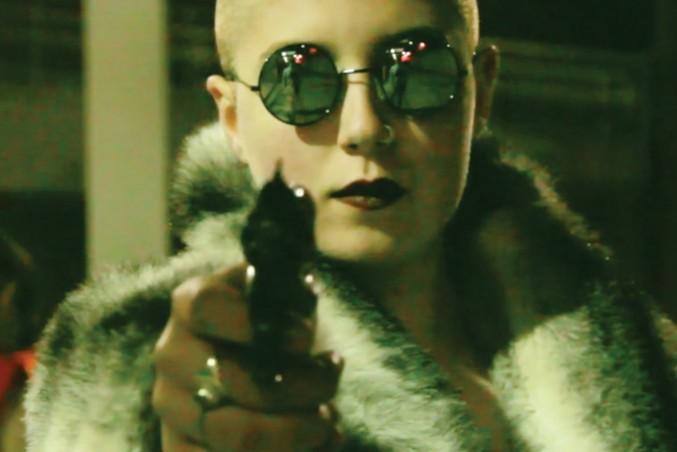By Dylan Freeman-Grist
Scott Jenner needs to blow his friend’s knee off with a revolver.
First, he has to clean the lube off a condom and then tie one end with a fishing line. Next, he pumps in fake blood before tying off the other side.
Jenner ties a piece of fishing wire to a washer before gluing it to the outer layer of the condom. With some medical tape to secure the ‘squib’ to his buddy’s knee and a quick flick of the wrist, the splatter effect is achieved.
“The suggestion is that explosion, or the burst,” says Jenner. “That one took a couple tries — that was something I had never done before.”
Jenner is a videographer. He’s shot music videos for bands in his hometown and is working on a sci-fi mini-series called Inner City Cult which demands the occasional blown knee or splattered brain.
Like most emerging artists, he often needs to produce high quality on a budget, which is not always as easy as fishline and Trojans.
“Basically there is a triangle with three different points: good, cost and time,” says Ian Wratschko, a fourth-year theatre production student and DIY FX junkie. “If you want two of the three things you’re going to lose the third. If you want two, be it fast and good you’re going to have to spend money … so making sure you have enough time is important.”
When Wratschko isn’t in class he punches his card at one of Toronto’s sculpture and effects shops, which welcomes new artists looking to gore out on a budget. He honed his craft in a special effects course taught at Ryerson before taking his love of the art on as a career.
The shop caters to all needs of young videographers looking to pull off stunts from dismemberments to gunshot wounds, monster heads to mask making.
In one scene, Jenner needed to crush an actor’s hand. He poured a reservoir of fake blood under the hand, and upon the hammer’s impact, a red pool oozed up through the fingers. By pairing the shot with the sound of cracking bones, the scene was complete.
“I just borrowed a silicone hand that a friend had made for another film,” says Jenner. “It was all painted, it had fingernails and everything, it looked good.”
Modelling and painting are a part of the game. It becomes necessary for everything from a minor gunshot wound to a convincing decapitation. Although this is where most filmmakers max out their credit cards, they don’t always need to.
“Latex is your friend,” says Wratschko, who advises it as a cheap alternative to silicone when creating masks and torn flesh.
For a simple gunshot wound, he notes one cost-effective route is to put a thin piece of latex on someone’s skin, then add a layer of cotton and more latex overtop. From there, the artist builds up a ring, lays on some fake blood and ties it together with make-up.
“There are tiers to how these things work,” adds Wratschko, who notes all budding filmmakers’ first step should be YouTube, which archives an endless supply of FX geeks showing off their craft.
But Wratschko advises to use common sense — not everyone who claims to be an expert has enough chops to back it up, a fact that could lead to a lot of wasted time on set or an injury at the worst.
“I’ve had people come in and ask if when I’m attaching silicone to their face, do I use super glue,” recalls Wratschko. “You just need to stop, and think about what some people are saying and think: ‘Does that actually make sense?’”
The need for special effects, however, is not limited to film.
Joseph Hammond is a fourth-year photography student at Ryerson. For the most part, his work deals in classical black and white studies of portraiture and nudes. For a third-year photo essay, he needed to add some blood and guts.
His work then delved into The Island of Dr. Moreau, a 1896 sci-fi novel by H.G. Wells. The book, which follows a mad scientist who demonizes and butchers people, required some help from the world of prosthetics.
Specifically, Hammond needed to document surgery scars which he managed to pin down pretty cheap by having Wratschko build them.
“I was playing with a cult mentality where the animals were proud of their surgery scars bringing them closer to being human and the ideas that the human was more monstrous then the animals,” says Hammond.
To achieve an acceptable level of fear and unease, artists like Hammond are the first to admit that gore is not always a priority.
“What comes to mind regarding film and photography and horror and makeup is it’s more atmosphere and an actors ability,” says Hammond, who recalls Marlon Brando’s out of focus, dimly lit and anxiety-riddled close up in Apocalypse Now, a shot with zero money spent on effects.
Instead of blood and guts, Hammond says the director plays with anticipation, weaving the plot and atmosphere as his most potent tools to fiddle with the viewers.
“Makeup is the last part of it all to validate the emotions of fear you already have.”










Leave a Reply